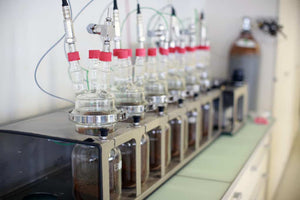How is the freshness of coffee measured?
When we buy a food product, in general we prefer to buy it as fresh as possible, unless this product involves some sort of aging / refinement / maturation.
For many foods, freshness is the must to fully savor their organoleptic properties, but for others, immediate consumption could represent a limit on the maximum organoleptic expression of the same, as in the case of aged wines or cheeses and, if we want, in part of the roasted coffee.
Premise:
Two years ago I had the pleasure of meeting Samo Smrke, Chahan Yeretzian and Marco Wellinger of the Zurich University of Applied Sciences Institute of Chemistry & Biotechnology in Switzerland in Zurich. We have known each other for a few years and we have had the opportunity to exchange views and opinions several times (obviously I am the one who listened to theirs).
They conducted the 2-year research of The Coffee Freshness published by SCA. (who an excerpt)

Let's begin…
Freshness, in fact, allows us to express the potential of food, but the term freshness takes on different meanings, whether we are talking about mozzarella, meat, oil, wine, or coffee (I could continue with a infinite list).
In the world of coffee there are different currents of thought, which are all right or wrong if you look at them from a different perspective.
The phases of freshness:
The thing that unites all these different currents of thought is that roasted coffee has 4 phases:
-
Maturation (of the aromatic part)
-
Degassing (usually begins with Maturation) (inexorable loss of the barrier effect)
-
Oxidation (attack by oxygen)
-
Rancidity (mutation into an unpleasant sensory experience)
As already mentioned, phase 1 and 2 start at the same time (perhaps Degassing begins shortly before as, already during roasting, the Gas is created and begins to "push to escape out of the grain").
Why is degassing (gas) so important?
It is the unit of measurement of the freshness of coffee, like a meter, it measures how much time has passed since that coffee was roasted, this in general, in spans.
We have said that the roasting process creates chemical modifications (in addition to the physical ones that are evident as a change in color, size and weight) which are very important when the Maillard reaction takes place (as I have already explained here), among these there are the degradations of Strecker.
Precisely these degradations create gases, for the most part carbon dioxide. Carbon Dioxide can be measured to determine the freshness (or not) of that coffee, knowing how long it was from, in consideration of the fact that it is trapped between the cells of the roasted coffee and that it manages to escape within a few weeks (degassing).
Ergo: less CO2, less freshness.
What is CO2?
CO2 is the substance that allows the espresso to make the cream on the surface (if there is no CO2, there is no emulsion), or the blooming during pre-infusion in the filter coffee.
The loss of carbon dioxide depends on several factors, which affect its speed:
Packaging (material and quality, but also atmospheric conditions, internal and external)
Toasting (fast or long, light or dark ... and all the nuances between them)
Type of coffee (its chemical composition)
Time (obviously)

So, in order not to go any further, how do I keep my coffee well?
An answer above all the other solutions is to buy a fresh roasted product and let it mature for the necessary time (usually at least 3-4 days in the case of filter roasts, at least 7 days for toasts suitable for espresso), but remember that it depends on many variables as we have just seen.
Conclusion:
Make sure you do not buy (but above all open!) Packages that you will not finish within ten days or at most a few weeks. Helps the coffee stay fresh by avoiding risky behaviors (heat, air, humidity).
But remember: Our coffees are vacuum-packed and subsequently in a protected atmosphere, precisely to eliminate as much oxygen contamination as possible already in the closed package, in coffee shop you can find our proposals of the moment.




